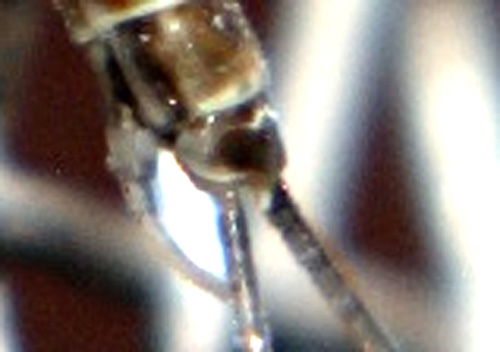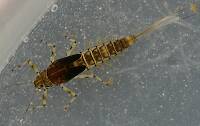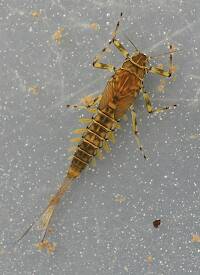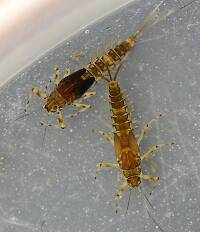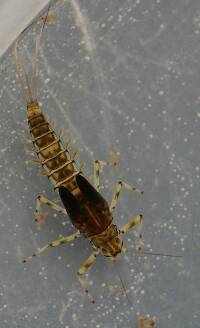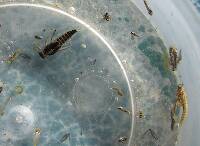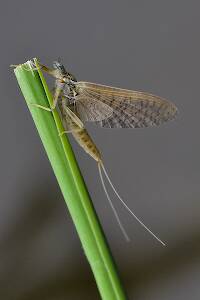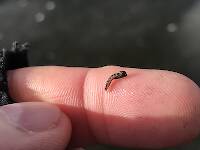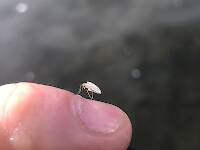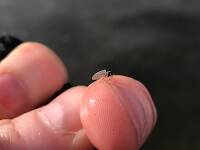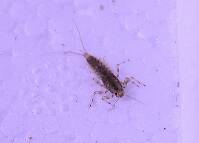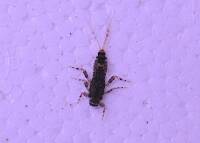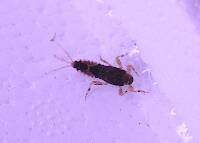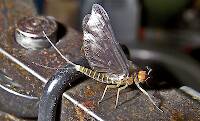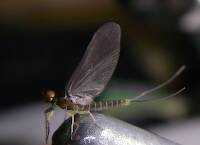
Blue-winged Olives
Baetis
Tiny Baetis mayflies are perhaps the most commonly encountered and imitated by anglers on all American trout streams due to their great abundance, widespread distribution, and trout-friendly emergence habits.
Featured on the forum


Troutnut is a project started in 2003 by salmonid ecologist Jason "Troutnut" Neuswanger to help anglers and
fly tyers unabashedly embrace the entomological side of the sport. Learn more about Troutnut or
support the project for an enhanced experience here.
Stclairj on Mar 24, 2012March 24th, 2012, 6:44 pm EDT
Hello everyone-
I live in the Yakima Valley (Washington State), and while working in the vineyard the other day I found this little guy. Our vineyard is about 10 miles north of the Yakima River, but there are numerous waterways used for irrigation surrounding the property, all of which come from the Yakima River. I usually fish the the Yakima this time of year, and we have a nice baetis hatch of what I am thinking is Baetis bicaudatis, usually a size 16-18. This one however is about one "size" larger, a #14 or so. Also, the abdomen seems pretty dark for the ones I usually see on the Yakima. Anyways, I am thinking either Baetis brunneicolor, or Baetis tricaudatus/vagans. So, the picture is of a spinner, and unfortunately I did not get a good shot of the penes, but there is a good view of the hind wings, and decent fore wings. Any ideas? Thanks in advance.
James
I live in the Yakima Valley (Washington State), and while working in the vineyard the other day I found this little guy. Our vineyard is about 10 miles north of the Yakima River, but there are numerous waterways used for irrigation surrounding the property, all of which come from the Yakima River. I usually fish the the Yakima this time of year, and we have a nice baetis hatch of what I am thinking is Baetis bicaudatis, usually a size 16-18. This one however is about one "size" larger, a #14 or so. Also, the abdomen seems pretty dark for the ones I usually see on the Yakima. Anyways, I am thinking either Baetis brunneicolor, or Baetis tricaudatus/vagans. So, the picture is of a spinner, and unfortunately I did not get a good shot of the penes, but there is a good view of the hind wings, and decent fore wings. Any ideas? Thanks in advance.
James
Entoman on Mar 24, 2012March 24th, 2012, 9:58 pm EDT
Hi James,
Welcome to the forum!
I have to admit it's a strange one to me. It looks like a little Gray Drake with baetid wings.:) Baetis tricaudatus is the common large western baetid that hatches in the Spring, and I don't see anything in the hind wing that points in a different direction. However, this species has several different hind wing configurations and without a more distinct look at its outline and venation, I can't say any more about that character. A close up of the ventral terminalia may help as well.
In any event, the body color throws me a little as I'm used to seeing somewhat paler middle terga with the males of NW tricaudatus. It is possible we could be looking at something entirely different or perhaps even new. Hopefully, my friend Taxon will check in and have something to add. If anybody can comment on the WA species of this most confounding family, it's him.
Best regards,
Welcome to the forum!
I have to admit it's a strange one to me. It looks like a little Gray Drake with baetid wings.:) Baetis tricaudatus is the common large western baetid that hatches in the Spring, and I don't see anything in the hind wing that points in a different direction. However, this species has several different hind wing configurations and without a more distinct look at its outline and venation, I can't say any more about that character. A close up of the ventral terminalia may help as well.
In any event, the body color throws me a little as I'm used to seeing somewhat paler middle terga with the males of NW tricaudatus. It is possible we could be looking at something entirely different or perhaps even new. Hopefully, my friend Taxon will check in and have something to add. If anybody can comment on the WA species of this most confounding family, it's him.
Best regards,
"It's not that I find fishing so important, it's just that I find all other endeavors of Man equally unimportant... And not nearly as much fun!" Robert Traver, Anatomy of a Fisherman
Taxon on Mar 25, 2012March 25th, 2012, 1:17 am EDT
Hello everyone-
I live in the Yakima Valley (Washington State), and while working in the vineyard the other day I found this little guy. Our vineyard is about 10 miles north of the Yakima River, but there are numerous waterways used for irrigation surrounding the property, all of which come from the Yakima River. I usually fish the the Yakima this time of year, and we have a nice baetis hatch of what I am thinking is Baetis bicaudatis, usually a size 16-18. This one however is about one "size" larger, a #14 or so. Also, the abdomen seems pretty dark for the ones I usually see on the Yakima. Anyways, I am thinking either Baetis brunneicolor, or Baetis tricaudatus/vagans. So, the picture is of a spinner, and unfortunately I did not get a good shot of the penes, but there is a good view of the hind wings, and decent fore wings. Any ideas? Thanks in advance.
James
Hi James,
Assuming this mayfly was found in Yakima County, I believe the only Baetis species reported there are B. bicaudatus and B. tricaudatus. As to the possibility of it being B. brunneicolor, that species has only been recorded from Lewis and Pierce Counties, which are across the Cascade Mountains in W. Washington. Of the Baetis species recorded in Yakima County, I believe the abdomen coloration comes far closer to matching B. bicaudatus, so absent anything else on which I can hang my hat, my guess is that's what it is.
Bnewell on Mar 25, 2012March 25th, 2012, 6:28 am EDT
James,
Very nice photos of a Baetid male. I think you will need to look at the penes and the hind wings in detail to identify this critter to species. I hope you collected specimens and are keeping them in 80% alcohol. If I could look at the mayfly more closely I might be able to get it to species. I have found B. tricaudatus to be very common in eastern Washington and B. bicaudataus more common in smaller, cleaner streams than the habitat you described.
Bob
Very nice photos of a Baetid male. I think you will need to look at the penes and the hind wings in detail to identify this critter to species. I hope you collected specimens and are keeping them in 80% alcohol. If I could look at the mayfly more closely I might be able to get it to species. I have found B. tricaudatus to be very common in eastern Washington and B. bicaudataus more common in smaller, cleaner streams than the habitat you described.
Bob
Entoman on Mar 25, 2012March 25th, 2012, 11:40 am EDT
Bob & Roger -
Just for the fun of it, I'm going to put an idea on the table. How about B. diablus?:)
I'm thinking of the paper McCafferty, et. al. did on obscure species of CA baetids back in '08. In it they describe diablus as a large, dark, anomalous species and suggest that it may turn out to simply be a color variation of tricaudatus. Apparently the lone documented examples were done by Day back in the 50's and it has yet to be associated with its nymph (as of '08). . I have to chuckle at diablus being mentioned by name in one of Merritt IV's couplets, evidently in the hope that somebody may run across another one on Mt. Diablo.:) I guess what I'm really saying is that this is probably just another example of the very ubiquitous and polytypic tricaudatis. The body size and large ovoid hind wings (for a baetid), not to mention odds due to population densities and distribution sure point in that direction.
Roger - I was thinking these dark ones with solid colored abdomens were a Southwestern thing, but this specimen shows perhaps that isn't the case. Remember that large dark tricaudatus from NM we did last year on your forum? It's a dead ringer for this one. http://www.flyfishingentomology.com/forum/Replies_Display.php?t=0037 Perhaps specimens like these will help solve the diablus anomaly someday.
James - Maybe I'm wrong in assuming the following and Bob would certainly know better, but I bet if you could capture a bunch of these, throw them in some vodka and ship them off to the ephemeropterists working on this topic, they'd be very interested... Luke?
Just for the fun of it, I'm going to put an idea on the table. How about B. diablus?:)
I'm thinking of the paper McCafferty, et. al. did on obscure species of CA baetids back in '08. In it they describe diablus as a large, dark, anomalous species and suggest that it may turn out to simply be a color variation of tricaudatus. Apparently the lone documented examples were done by Day back in the 50's and it has yet to be associated with its nymph (as of '08). . I have to chuckle at diablus being mentioned by name in one of Merritt IV's couplets, evidently in the hope that somebody may run across another one on Mt. Diablo.:) I guess what I'm really saying is that this is probably just another example of the very ubiquitous and polytypic tricaudatis. The body size and large ovoid hind wings (for a baetid), not to mention odds due to population densities and distribution sure point in that direction.
Roger - I was thinking these dark ones with solid colored abdomens were a Southwestern thing, but this specimen shows perhaps that isn't the case. Remember that large dark tricaudatus from NM we did last year on your forum? It's a dead ringer for this one. http://www.flyfishingentomology.com/forum/Replies_Display.php?t=0037 Perhaps specimens like these will help solve the diablus anomaly someday.
James - Maybe I'm wrong in assuming the following and Bob would certainly know better, but I bet if you could capture a bunch of these, throw them in some vodka and ship them off to the ephemeropterists working on this topic, they'd be very interested... Luke?
"It's not that I find fishing so important, it's just that I find all other endeavors of Man equally unimportant... And not nearly as much fun!" Robert Traver, Anatomy of a Fisherman
Stclairj on Mar 25, 2012March 25th, 2012, 1:28 pm EDT
Thank you all for your replies. Unfortunately I was out on my 4-wheeler doing some bud counts, and while I always bring my camera, I was not expecting to see any ephemeroptera out there, so I was unable to collect a specimen. After this guy randomly landed on my 4-wheeler, I started to keep my eye out a little more for them. I did see about 6 or 7 at one point flying about 5 feet above me (all spinners, doing the mating dance).
We do have a couple of irrigation ponds on the property, so at first thought I assumed callibaetis based on size. It has been a while since I have done any id's, so I had forgotten that the callibaetis usually has more pronounced hind wings, and usually some color in the fore wings. Given the time of year, and that I had been fishing recently and seen some baetis out, I then assumed B. tricaudatus, as it is the most widespread baetis. However, the size is what really got me. If I were out fishing I would have tied on a size 14, perhaps even a 12.
I also have just purchased the Nikon D-3100, and while I have some experience with macro photography, I am still learning my camera. I found this situation pretty lucky. Rarely have I had a mayfly land somewhere and pose for me, so these pictures were "right place, right time."
I will be out again in the vineyard tomorrow, and I'll keep my eye out for some more, and I will have the appropriate materials to collect a specimen. Thank you again for all of your comments!
We do have a couple of irrigation ponds on the property, so at first thought I assumed callibaetis based on size. It has been a while since I have done any id's, so I had forgotten that the callibaetis usually has more pronounced hind wings, and usually some color in the fore wings. Given the time of year, and that I had been fishing recently and seen some baetis out, I then assumed B. tricaudatus, as it is the most widespread baetis. However, the size is what really got me. If I were out fishing I would have tied on a size 14, perhaps even a 12.
I also have just purchased the Nikon D-3100, and while I have some experience with macro photography, I am still learning my camera. I found this situation pretty lucky. Rarely have I had a mayfly land somewhere and pose for me, so these pictures were "right place, right time."
I will be out again in the vineyard tomorrow, and I'll keep my eye out for some more, and I will have the appropriate materials to collect a specimen. Thank you again for all of your comments!
Entoman on Mar 25, 2012March 25th, 2012, 2:33 pm EDT
Guys,
Now that Jim has given a fuller description of where he saw it and how big it was, I'm going in a little different direction. I looked closer at the hind wing of the specimen from Taxon's site http://www.flyfishingentomology.com/forum/Replies_Display.php?t=0037, and noticed the projection is in line with the basal anterior wing margin almost forming a straight line. This character is supposed to be very unique and considered diagnostic. I am beginning to think both are probably species of the silt loving Camelobaetidius genus, probably inhabiting the irrigation ditches he mentioned. If so, these photos may be among the first of live adult specimens.
I remember wrestling with the possibility at the time last year, but for some reason thought they were austral in distribution. I see now that they are in North America, with a couple of species even listed for the Northwest.
Now that Jim has given a fuller description of where he saw it and how big it was, I'm going in a little different direction. I looked closer at the hind wing of the specimen from Taxon's site http://www.flyfishingentomology.com/forum/Replies_Display.php?t=0037, and noticed the projection is in line with the basal anterior wing margin almost forming a straight line. This character is supposed to be very unique and considered diagnostic. I am beginning to think both are probably species of the silt loving Camelobaetidius genus, probably inhabiting the irrigation ditches he mentioned. If so, these photos may be among the first of live adult specimens.
I remember wrestling with the possibility at the time last year, but for some reason thought they were austral in distribution. I see now that they are in North America, with a couple of species even listed for the Northwest.
"It's not that I find fishing so important, it's just that I find all other endeavors of Man equally unimportant... And not nearly as much fun!" Robert Traver, Anatomy of a Fisherman
Entoman on Mar 30, 2012March 30th, 2012, 11:13 am EDT
Any thoughts on my last post?
"It's not that I find fishing so important, it's just that I find all other endeavors of Man equally unimportant... And not nearly as much fun!" Robert Traver, Anatomy of a Fisherman
Konchu on Apr 1, 2012April 1st, 2012, 1:25 pm EDT
Entoman, thanks for drawing my attention back to this. Mainly posting now to bring this back to the fore for discussion. I did look at this last week in passing, but got busy and forgot all about it.
I, too, thought about Baetis diablus and some of the other obscure Baetis species from the West, but I didn't follow through on any of them. I may also check some of the old names that have been sunk under other even older names.
Hard for me to see enough to say comfortably whether this indeed Baetis, or whether it could, in fact, be some other genus. I'm curious about the habitats around. From what's been described habitat-wise, Baetis would be my starting guess.
Does the terminal segment to the genital forceps appear at least a little elongate to anyone else?
Stclairj: Have any of the real ones been pickled for posterity?
I, too, thought about Baetis diablus and some of the other obscure Baetis species from the West, but I didn't follow through on any of them. I may also check some of the old names that have been sunk under other even older names.
Hard for me to see enough to say comfortably whether this indeed Baetis, or whether it could, in fact, be some other genus. I'm curious about the habitats around. From what's been described habitat-wise, Baetis would be my starting guess.
Does the terminal segment to the genital forceps appear at least a little elongate to anyone else?
Stclairj: Have any of the real ones been pickled for posterity?
Entoman on Apr 1, 2012April 1st, 2012, 1:38 pm EDT
Hi Luke,
Yes it does, but I can't quite make out enough to tell how much nor the shape/ thickness (in the right spots) of the long mid. seg.
What really intrigued my though was Roger's photo in the link. It looks to be the identical twin, right down to the thoracic markings (though the eyes appear a little more turbinate, but that could be camera angle angle or variation). In Roger's the hind wing is clearly viewable. The straight basal margin inline with the projection is very interesting. Also, the silty and probably somewhat warmer conditions in the irrigation ditches nearby as this critters probable home.
Does the terminal segment to the genital forceps appear at least a little elongate to anyone else?
Yes it does, but I can't quite make out enough to tell how much nor the shape/ thickness (in the right spots) of the long mid. seg.
What really intrigued my though was Roger's photo in the link. It looks to be the identical twin, right down to the thoracic markings (though the eyes appear a little more turbinate, but that could be camera angle angle or variation). In Roger's the hind wing is clearly viewable. The straight basal margin inline with the projection is very interesting. Also, the silty and probably somewhat warmer conditions in the irrigation ditches nearby as this critters probable home.
"It's not that I find fishing so important, it's just that I find all other endeavors of Man equally unimportant... And not nearly as much fun!" Robert Traver, Anatomy of a Fisherman
Taxon on Apr 1, 2012April 1st, 2012, 3:43 pm EDT
Entoman on Apr 1, 2012April 1st, 2012, 8:07 pm EDT
Thanks Roger,
Too bad that pesky cercus is in the way and we can't see the terminal seg. From what I can make out, the two specimens do seem to have very similar terminalia.
Too bad that pesky cercus is in the way and we can't see the terminal seg. From what I can make out, the two specimens do seem to have very similar terminalia.
"It's not that I find fishing so important, it's just that I find all other endeavors of Man equally unimportant... And not nearly as much fun!" Robert Traver, Anatomy of a Fisherman
Konchu on Apr 3, 2012April 3rd, 2012, 5:57 am EDT
I'm leaning towards a Baetis species for this one, mainly due to the relatively broad hindwing that is rounded on the posterior (bottom) margin. The body coloration is very close to Baetis brunneicolor, but the abdominal sterna appear too dark, and the legs might be too dark. Some of that could be due to light effects, though. The really dark lateral patches of color on the abdomen stand out to me and might be important. Of course, I'd have to see the real thing to be sure about any ID. Maybe stclairj got specimens.
Entoman on Apr 3, 2012April 3rd, 2012, 8:38 am EDT
Baetids are difficult (thought I'd shoot for understatement of the week). :)
"It's not that I find fishing so important, it's just that I find all other endeavors of Man equally unimportant... And not nearly as much fun!" Robert Traver, Anatomy of a Fisherman
Konchu on Apr 3, 2012April 3rd, 2012, 9:51 am EDT
Baetids are difficult
Admitting you have a problem is the first step to recovery.
Entoman on Apr 3, 2012April 3rd, 2012, 3:10 pm EDT
:):)LOL. Like the happy drunk, I'm enjoying myself so I don't see it as a problem.
"It's not that I find fishing so important, it's just that I find all other endeavors of Man equally unimportant... And not nearly as much fun!" Robert Traver, Anatomy of a Fisherman
Jmw975 on Apr 5, 2012April 5th, 2012, 6:24 am EDT
What about B. magnus? It has the dark lateral streaks on the abdomen and a fairly straight leading margin on the hind wing, and it looks like there is a small marking on the fore femur and the bases of the antennae are quite dark. The thorax and sterna seem a bit dark and the pale rings around the abdomen more distinct than what I remember of magnus, however.
Jeff
Jeff
Taxon on Apr 5, 2012April 5th, 2012, 8:24 am EDT
Hi Jeff-
I believe the closest Baetis magnus records to Yakima, WA are from SD and CO, both over 800 miles distant.
I believe the closest Baetis magnus records to Yakima, WA are from SD and CO, both over 800 miles distant.
Entoman on Apr 5, 2012April 5th, 2012, 11:02 am EDT
Everybody -
Well, I think we've got this one surrounded.:)
Based on size and observable characters (especially what we can see of the forceps) it sure looks to be in the rhodani group of species which includes all our speculations excepting mine about Camelobaetidius (too dissimilar in the forceps upon closer observation to remain a possibility).
It is my understanding there is a lot to resolve with this group. Since tricaudatus is ubiquitous and highly variable and information on the large species magnus and diablus is so scant, am I right in assuming at least the following possibilities about these obscure baetids?
a. closely related but separate species that exist in scattered small populations (often cohabiting with tricaudatus)
b. the same species but a different form of tricaudatus
c. subspecies of tricaudatus
That's a lot of options.:)
McCafferty suggested that diablus may eventually be synonymized with tricaudatus in the paper referenced in the above post. Regarding magnus, the following quote best illustrates the difficulty with this group as a whole:
This last quote is 26 years old though. Does anybody have more current information they could share? Your mention (Luke & Jeff) of the lateral color bands as a useful character is something I haven't heard before.
Well, I think we've got this one surrounded.:)
Based on size and observable characters (especially what we can see of the forceps) it sure looks to be in the rhodani group of species which includes all our speculations excepting mine about Camelobaetidius (too dissimilar in the forceps upon closer observation to remain a possibility).
It is my understanding there is a lot to resolve with this group. Since tricaudatus is ubiquitous and highly variable and information on the large species magnus and diablus is so scant, am I right in assuming at least the following possibilities about these obscure baetids?
a. closely related but separate species that exist in scattered small populations (often cohabiting with tricaudatus)
b. the same species but a different form of tricaudatus
c. subspecies of tricaudatus
That's a lot of options.:)
McCafferty suggested that diablus may eventually be synonymized with tricaudatus in the paper referenced in the above post. Regarding magnus, the following quote best illustrates the difficulty with this group as a whole:
McCafferty & Waltz '86
Because we possess only one reared female subimago of B. magnus and one associated but not reared male adult, and because adults of the rhodani group are essentially inseperable at the species level (emphasis mine) on the basis of current information, any description of the adult at this time would be tenuous.
This last quote is 26 years old though. Does anybody have more current information they could share? Your mention (Luke & Jeff) of the lateral color bands as a useful character is something I haven't heard before.
"It's not that I find fishing so important, it's just that I find all other endeavors of Man equally unimportant... And not nearly as much fun!" Robert Traver, Anatomy of a Fisherman
Quick Reply
Related Discussions
Topic
Replies
Last Reply
0
Nov 6, 2020
by Troutnut
by Troutnut






